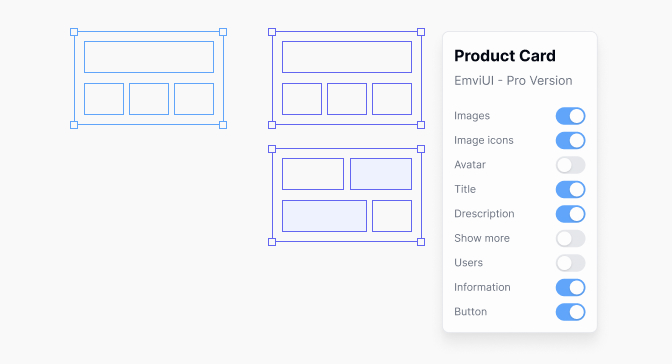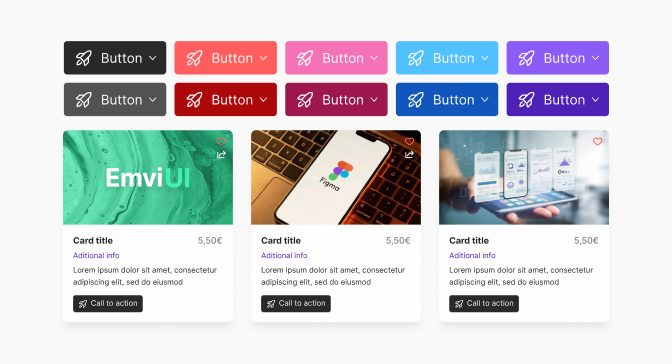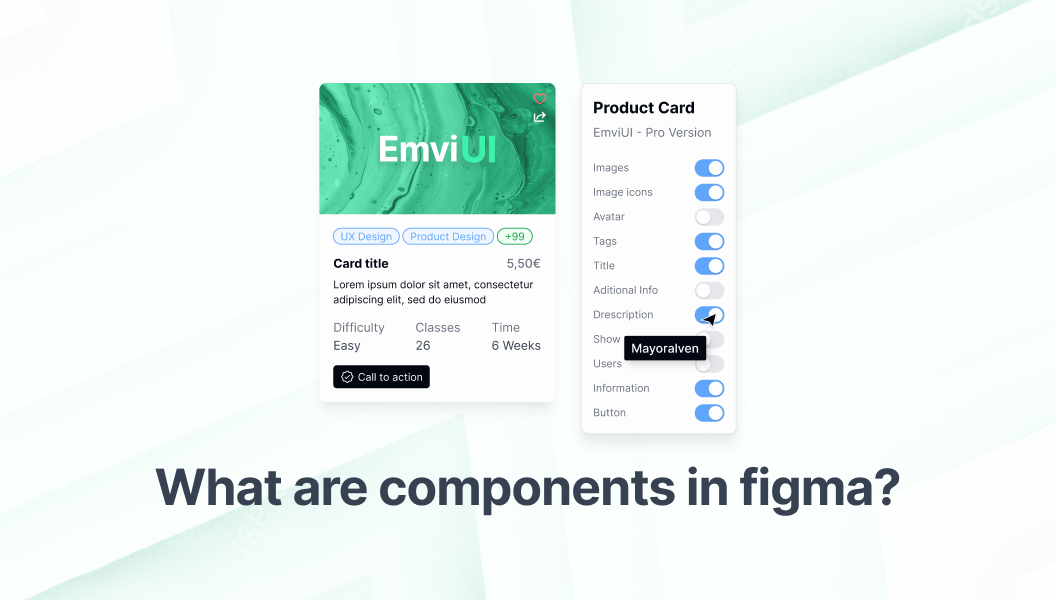What is a component in Figma?
A component in Figma is a reusable element that acts as a master version of a design. When you create an instance of a component, any changes you make to the master will automatically update across all instances.
Components can be as simple as a single button or as complex as a full navigation bar. They're essential for maintaining consistency, especially in larger projects where multiple designers work together.
For example, in EmviUI, the button component includes all states - default, hover, pressed, and disabled - so updating the master automatically updates every button across hundreds of screens.
What is the difference between frames and components in Figma?
Frames and components might look similar, but their purposes are different:
- Frame - A container used for grouping and organizing elements. Frames can be artboards, sections of a layout, or containers for responsive design using Auto Layout.
- Component - A reusable design element with a master-instance relationship. Components are built within frames but have the added benefit of linked updates.
Analogy: Think of a frame as a folder and a component as a template. You can create many frames, but only components will sync changes across all uses.

What is the difference between styles and components in Figma?
Styles define visual attributes (like color, typography, or effects), while components define structure and behavior (layout, grouping, and states).
- Styles - Used for colors, text properties, effects, and grid systems. Updating a style changes the visual property everywhere it's used.
- Components - Used for interactive or structural elements that can be reused (buttons, cards, inputs).
In EmviUI, styles and components work together: styles define the brand's color palette, and components apply those styles to consistent, reusable UI elements.
What is the difference between components and variants in Figma?
Components are the base building blocks, while variants are different versions of a component grouped together.
- Component - One master element with linked instances.
- Variant - Multiple related components (e.g., button sizes, states) combined into one organized set.
Variants make switching between different versions of a component quick and intuitive without needing separate masters for each variation. In EmviUI, the button component has variants for size (small, medium, large) and state (default, hover, active, disabled).
How do I make something a component in Figma?
Creating a component is simple:
- Select the frame or group of elements you want to reuse.
- Right-click and choose Create Component, or use the shortcut Ctrl + Alt + K (Windows) / Cmd + Option + K (Mac).
- Your selection becomes the master component, indicated by a purple outline and diamond icon.
You can now create instances by dragging from the Assets panel or copying the component onto other pages.

What does it mean to publish a component in Figma?
Publishing a component makes it available in a shared Figma Library so your entire team can use it in any project.
To publish:
- Place your component in a designated library file (e.g., "Design System").
- Click the Assets panel -> Library icon.
- Enable the library and click Publish.
- Team members can now insert the component into their files, with updates syncing automatically.
Publishing ensures everyone uses the same version, preventing inconsistencies. In EmviUI, all 10,000+ components are pre-published for easy team adoption.
Benefits of using components in Figma
- Consistency - Ensure every button, card, or input looks the same everywhere.
- Efficiency - Update hundreds of elements in seconds.
- Scalability - Easily manage growing projects without design drift.
- Collaboration - Multiple designers can work on different screens while using the same components.
Common mistakes with components
- Overusing nested components unnecessarily.
- Failing to name components clearly.
- Not organizing components in a master library.
- Creating components without using styles for colors and typography.
How EmviUI uses components
EmviUI is a TailwindCSS-based design system built entirely with optimized Figma components. Every element - from buttons to tables - is a reusable, well-organized component with variants and style bindings. This allows teams to create professional designs in hours instead of weeks.
Frequently Asked Questions (FAQs)
What is a component in Figma?
A reusable design element that acts as a master template, keeping all instances in sync when updated.
What's the difference between a frame and a component?
Frames are containers; components are reusable design templates with a master-instance relationship.
How are styles different from components?
Styles control visual properties like colors and text; components control structure and reusability.
What are variants in Figma?
Variants are multiple versions of a component (e.g., different states or sizes) grouped together for easy swapping.
How do I create a component?
Select your design, right-click, and choose "Create Component" or use Ctrl/Cmd + Option/Alt + K.
What does publishing a component mean?
Publishing makes the component available in a shared library so other team members can use and update it.
Can I update a component after publishing?
Yes. Updating the master and republishing updates all instances across linked files.
Does EmviUI use components?
Yes, all EmviUI elements are components with variants, ready for professional design workflows.


